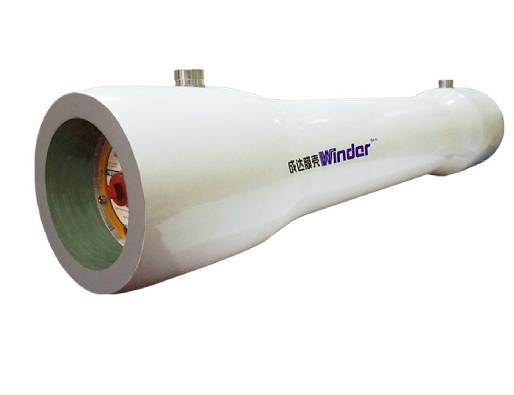Reverse osmosis is the use of reverse osmosis pressure to achieve the separation and purification of water, which can effectively remove salts, small molecule organic matter and colloids in water. It is generally used for desalination in wastewater regeneration treatment. Reverse osmosis membrane pollution is the main factor restricting the wide application of reverse osmosis process. The causes of pollution in reverse osmosis membrane housings include concentration polarization, ionic scaling, metal oxide deposition, organic pollution, colloidal pollution, biological pollution, grease pollution, etc. Due to the complexity of water quality, in actual operation, membrane pollution is mostly the result of the synergy of the above factors.
The main factors affecting the reverse osmosis membrane pollution are membrane material, influent water quality, etc.
1. Operating conditions (system recovery rate, water temperature, pressure, pH), etc. Research results show that the hydrophobic membrane is beneficial to desalination, but it is not conducive to the removal of organic matter, and it is more likely to be clogged than the hydrophilic membrane. The rougher the membrane surface, the more contaminated it is. Operating conditions such as water temperature, pressure, and pH are also closely related to membrane fouling rates. As the water temperature rises, the membrane flux increases, but it cannot exceed the maximum withstand temperature of the membrane, otherwise it will affect the life of the membrane. As the pressure increases, the membrane flux increases. After the value exceeds a certain pressure, the faster the deposition rate of pollutants on the membrane surface, the membrane flux will decrease. At higher pH, organic molecules and membrane surface are negatively charged, due to electrostatic repulsion
The pollution rate of organic matter decreases, but inorganic scaling is prone to occur.

Reverse Osmosis Membrane Pressure Vessels
The main reasons for reducing membrane pollution in practice are the following: the newly installed pipelines are not cleaned before the system runs, and contain dust, impurities, etc .; the design of the pretreatment device is unreasonable, and the water quality does not meet the requirements of reverse osmosis influent: use of chemical Add files; microbial contamination in the membrane pool: operational errors, etc. The measures to prevent reverse osmosis membrane pollution are divided into the following aspects:
1) R & D and use of low-pollution membranes, membrane surface modification, etc. The PROC series of low-pollution membranes developed by American Hyde Energy Co., Ltd. are more resistant to pollution and easy to clean because of their smooth surface, wide inlet screen, and dense aromatic cortex gum separation skin.
2) Choose appropriate pretreatment to improve the quality of influent water. Select a reasonable pretreatment method according to the characteristics of the raw water to remove or reduce pollutants, which can delay the rate of reverse osmosis membrane pollution. For the removal of substances, oxidation, activated carbon adsorption, etc. can be used; for the removal of suspended matter and colloids, flocculation, adsorption, wave pass, ultrafiltration, etc. can be used: for microorganisms, ultraviolet sterilization, sterilization, etc. Scale inorganic salt, lime softening and scale inhibitor can be used.
3) Optimization of design parameters and operating conditions. Different membrane elements have specific requirements for membrane operating conditions, and optimization in accordance with actual conditions during operation can effectively reduce the membrane fouling rate. However, fouling of reverse osmosis membranes is inevitable. When the membrane pollution reaches a certain level, it will cause a decrease in water production and desalination rate, and an increase in pressure difference. If it is not cleaned in time, it will affect the performance of the membrane and shorten the life of the membrane. Cleaning methods include mechanical cleaning, raccoon cleaning, learning cleaning, biological cleaning, etc. Mechanical cleaning is generally only suitable for the cleaning of soft dirt, and the scope of application is limited. Physical cleaning includes high-pressure pure water forward or reverse flushing, etc., which has a good effect on the pollution caused by the filter cake. Chemical cleaning uses acids, alkalis, surfactants, integrants, etc. to react with contaminants. The cleaning effect is good and the efficiency is high. It is the most commonly used cleaning method. In operation, the appropriate chemical cleaning agent and cleaning method should be selected according to the type of membrane contaminants.
The combination of acid washing and alkaline washing can effectively restore the reverse osmosis membrane pressure vessels. If the membrane fouling is serious, you can extend the soaking time and add a stripping and separating agent. In recent years, research and practice of ultrasonic cleaning and biological cleaning have also been carried out. Keyang et al. Used ultrasonic-assisted lye to clean the reverse osmosis membrane. The test results show that the use of super-assisted lye to clean can improve the cleaning efficiency and reduce the consumption of chemical agents. The test results of anaerobic bacteria to remove organic scale from the reverse osmosis membrane show that inoculation Anaerobic bacteria can effectively remove the pollution of organic scale.